Analysis of Change Management Strategies at Schloss Horgen gGmbH
VerifiedAdded on 2021/06/17
|7
|1657
|207
Report
AI Summary
This report provides a comprehensive analysis of change management within the Schloss Horgen gGmbH, a boarding school facing new competition. It examines the leadership approaches of key figures, including the CEO, marketing coordinator, and others, focusing on information dissemination and employee involvement. The report delves into the various change management practices employed, the leadership styles exhibited, and the impact of the organization's culture on the change process. It highlights the barriers to implementing changes, such as the organization's initial belief in its invincibility, and evaluates the application of Kotter's 8-step change model. The analysis concludes with recommendations for future actions, emphasizing the importance of focusing on positive reinforcement, employee empowerment, and effective communication to improve the organization's ability to adapt and thrive.
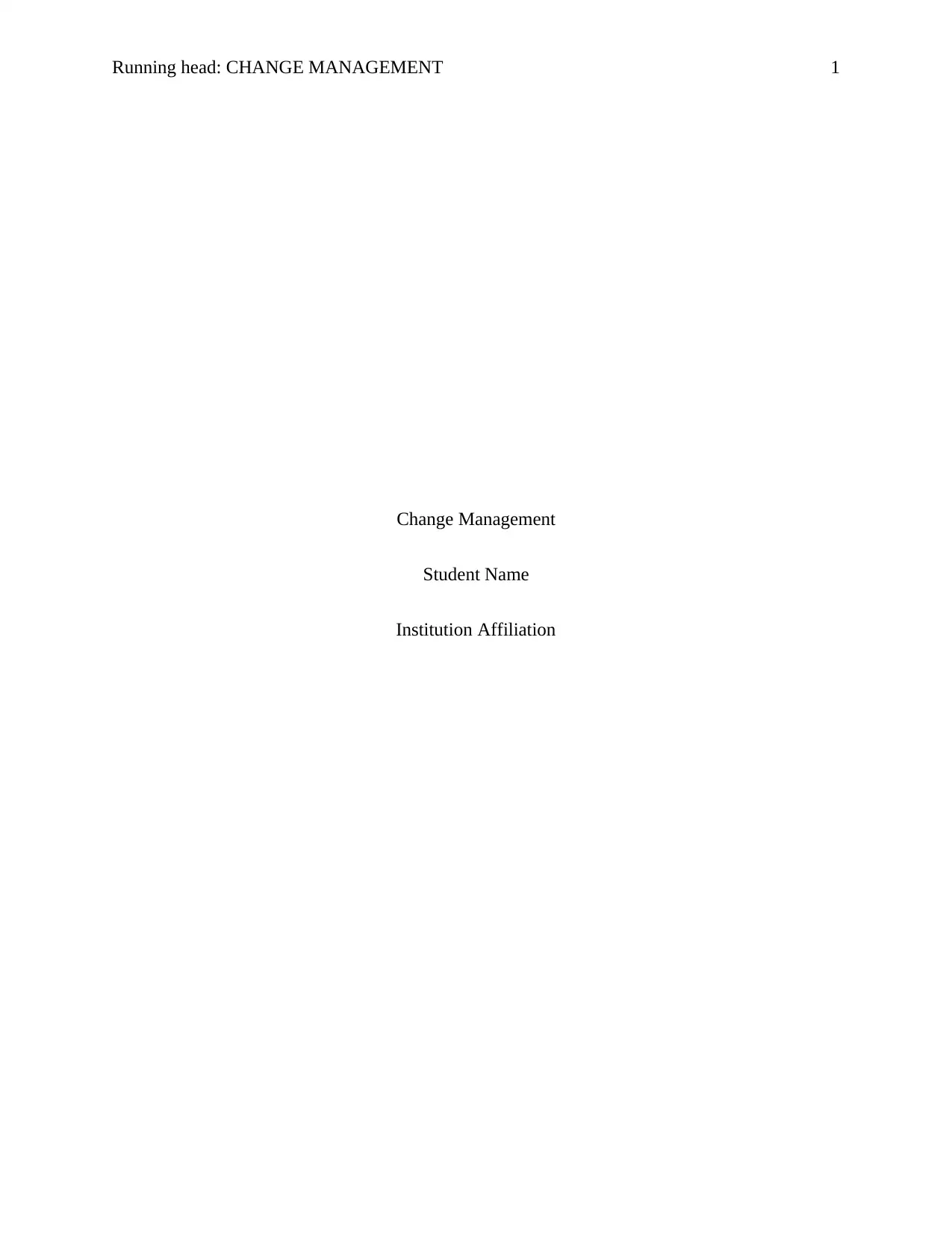
Running head: CHANGE MANAGEMENT 1
Change Management
Student Name
Institution Affiliation
Change Management
Student Name
Institution Affiliation
Paraphrase This Document
Need a fresh take? Get an instant paraphrase of this document with our AI Paraphraser
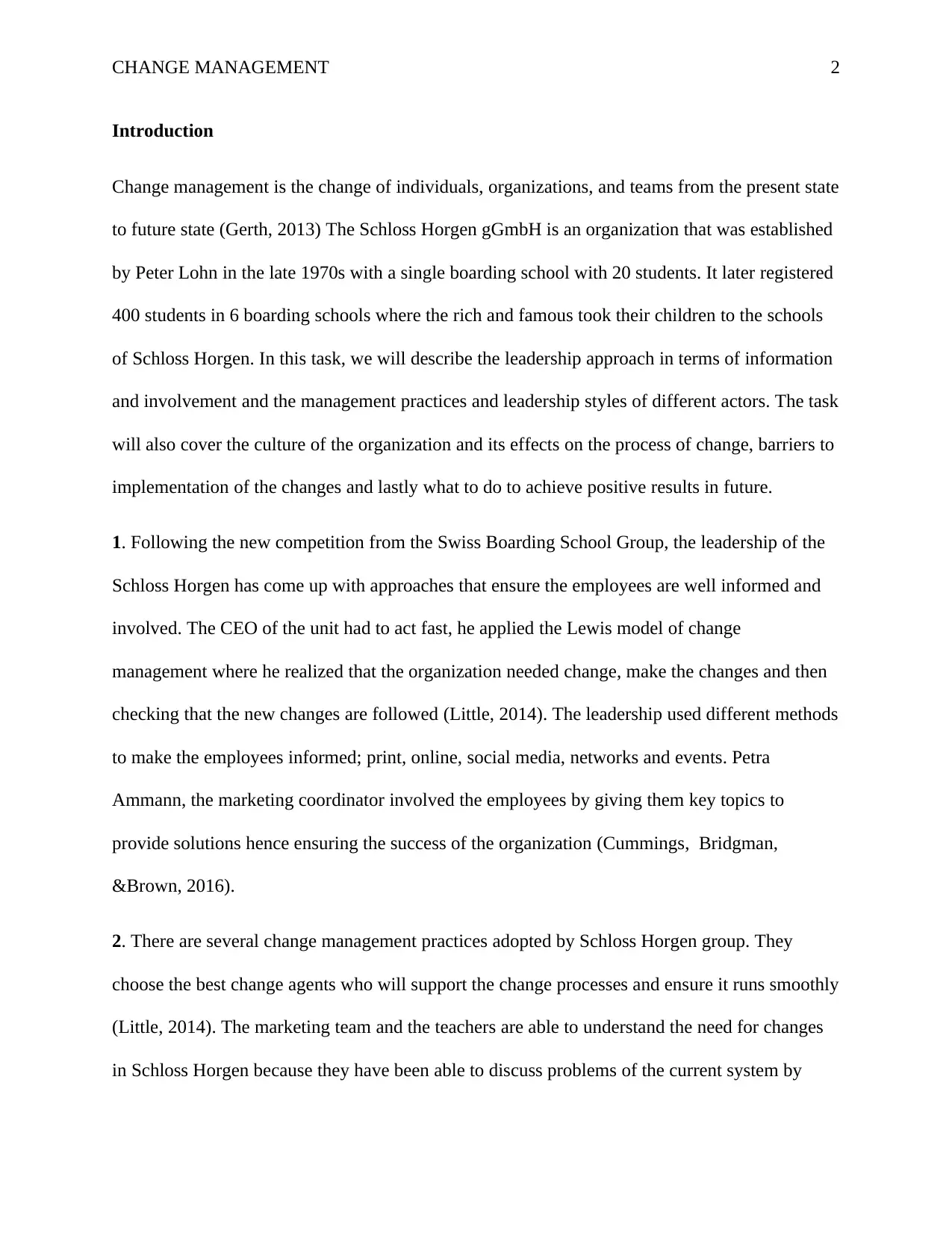
CHANGE MANAGEMENT 2
Introduction
Change management is the change of individuals, organizations, and teams from the present state
to future state (Gerth, 2013) The Schloss Horgen gGmbH is an organization that was established
by Peter Lohn in the late 1970s with a single boarding school with 20 students. It later registered
400 students in 6 boarding schools where the rich and famous took their children to the schools
of Schloss Horgen. In this task, we will describe the leadership approach in terms of information
and involvement and the management practices and leadership styles of different actors. The task
will also cover the culture of the organization and its effects on the process of change, barriers to
implementation of the changes and lastly what to do to achieve positive results in future.
1. Following the new competition from the Swiss Boarding School Group, the leadership of the
Schloss Horgen has come up with approaches that ensure the employees are well informed and
involved. The CEO of the unit had to act fast, he applied the Lewis model of change
management where he realized that the organization needed change, make the changes and then
checking that the new changes are followed (Little, 2014). The leadership used different methods
to make the employees informed; print, online, social media, networks and events. Petra
Ammann, the marketing coordinator involved the employees by giving them key topics to
provide solutions hence ensuring the success of the organization (Cummings, Bridgman,
&Brown, 2016).
2. There are several change management practices adopted by Schloss Horgen group. They
choose the best change agents who will support the change processes and ensure it runs smoothly
(Little, 2014). The marketing team and the teachers are able to understand the need for changes
in Schloss Horgen because they have been able to discuss problems of the current system by
Introduction
Change management is the change of individuals, organizations, and teams from the present state
to future state (Gerth, 2013) The Schloss Horgen gGmbH is an organization that was established
by Peter Lohn in the late 1970s with a single boarding school with 20 students. It later registered
400 students in 6 boarding schools where the rich and famous took their children to the schools
of Schloss Horgen. In this task, we will describe the leadership approach in terms of information
and involvement and the management practices and leadership styles of different actors. The task
will also cover the culture of the organization and its effects on the process of change, barriers to
implementation of the changes and lastly what to do to achieve positive results in future.
1. Following the new competition from the Swiss Boarding School Group, the leadership of the
Schloss Horgen has come up with approaches that ensure the employees are well informed and
involved. The CEO of the unit had to act fast, he applied the Lewis model of change
management where he realized that the organization needed change, make the changes and then
checking that the new changes are followed (Little, 2014). The leadership used different methods
to make the employees informed; print, online, social media, networks and events. Petra
Ammann, the marketing coordinator involved the employees by giving them key topics to
provide solutions hence ensuring the success of the organization (Cummings, Bridgman,
&Brown, 2016).
2. There are several change management practices adopted by Schloss Horgen group. They
choose the best change agents who will support the change processes and ensure it runs smoothly
(Little, 2014). The marketing team and the teachers are able to understand the need for changes
in Schloss Horgen because they have been able to discuss problems of the current system by
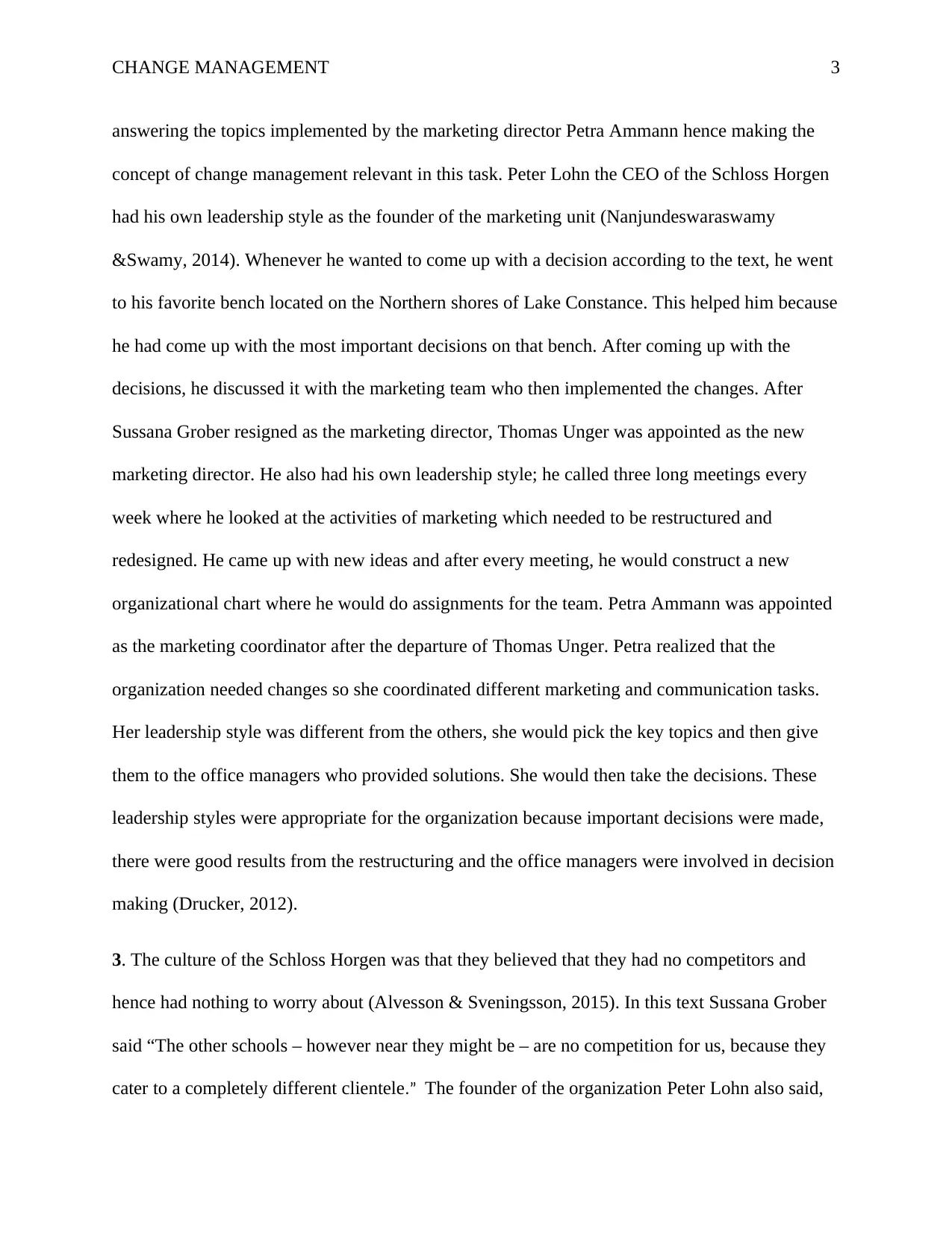
CHANGE MANAGEMENT 3
answering the topics implemented by the marketing director Petra Ammann hence making the
concept of change management relevant in this task. Peter Lohn the CEO of the Schloss Horgen
had his own leadership style as the founder of the marketing unit (Nanjundeswaraswamy
&Swamy, 2014). Whenever he wanted to come up with a decision according to the text, he went
to his favorite bench located on the Northern shores of Lake Constance. This helped him because
he had come up with the most important decisions on that bench. After coming up with the
decisions, he discussed it with the marketing team who then implemented the changes. After
Sussana Grober resigned as the marketing director, Thomas Unger was appointed as the new
marketing director. He also had his own leadership style; he called three long meetings every
week where he looked at the activities of marketing which needed to be restructured and
redesigned. He came up with new ideas and after every meeting, he would construct a new
organizational chart where he would do assignments for the team. Petra Ammann was appointed
as the marketing coordinator after the departure of Thomas Unger. Petra realized that the
organization needed changes so she coordinated different marketing and communication tasks.
Her leadership style was different from the others, she would pick the key topics and then give
them to the office managers who provided solutions. She would then take the decisions. These
leadership styles were appropriate for the organization because important decisions were made,
there were good results from the restructuring and the office managers were involved in decision
making (Drucker, 2012).
3. The culture of the Schloss Horgen was that they believed that they had no competitors and
hence had nothing to worry about (Alvesson & Sveningsson, 2015). In this text Sussana Grober
said “The other schools – however near they might be – are no competition for us, because they
cater to a completely different clientele.” The founder of the organization Peter Lohn also said,
answering the topics implemented by the marketing director Petra Ammann hence making the
concept of change management relevant in this task. Peter Lohn the CEO of the Schloss Horgen
had his own leadership style as the founder of the marketing unit (Nanjundeswaraswamy
&Swamy, 2014). Whenever he wanted to come up with a decision according to the text, he went
to his favorite bench located on the Northern shores of Lake Constance. This helped him because
he had come up with the most important decisions on that bench. After coming up with the
decisions, he discussed it with the marketing team who then implemented the changes. After
Sussana Grober resigned as the marketing director, Thomas Unger was appointed as the new
marketing director. He also had his own leadership style; he called three long meetings every
week where he looked at the activities of marketing which needed to be restructured and
redesigned. He came up with new ideas and after every meeting, he would construct a new
organizational chart where he would do assignments for the team. Petra Ammann was appointed
as the marketing coordinator after the departure of Thomas Unger. Petra realized that the
organization needed changes so she coordinated different marketing and communication tasks.
Her leadership style was different from the others, she would pick the key topics and then give
them to the office managers who provided solutions. She would then take the decisions. These
leadership styles were appropriate for the organization because important decisions were made,
there were good results from the restructuring and the office managers were involved in decision
making (Drucker, 2012).
3. The culture of the Schloss Horgen was that they believed that they had no competitors and
hence had nothing to worry about (Alvesson & Sveningsson, 2015). In this text Sussana Grober
said “The other schools – however near they might be – are no competition for us, because they
cater to a completely different clientele.” The founder of the organization Peter Lohn also said,
⊘ This is a preview!⊘
Do you want full access?
Subscribe today to unlock all pages.

Trusted by 1+ million students worldwide
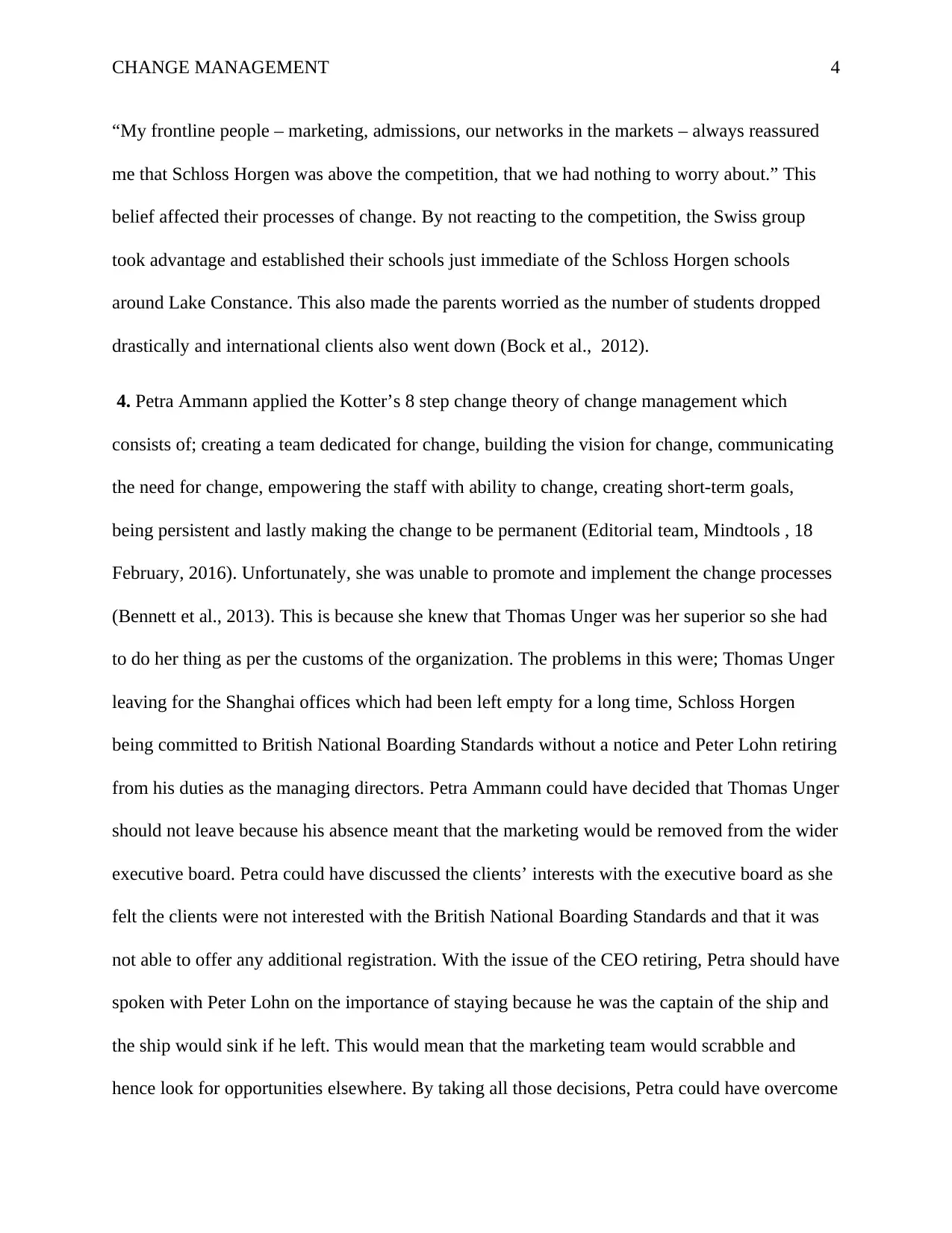
CHANGE MANAGEMENT 4
“My frontline people – marketing, admissions, our networks in the markets – always reassured
me that Schloss Horgen was above the competition, that we had nothing to worry about.” This
belief affected their processes of change. By not reacting to the competition, the Swiss group
took advantage and established their schools just immediate of the Schloss Horgen schools
around Lake Constance. This also made the parents worried as the number of students dropped
drastically and international clients also went down (Bock et al., 2012).
4. Petra Ammann applied the Kotter’s 8 step change theory of change management which
consists of; creating a team dedicated for change, building the vision for change, communicating
the need for change, empowering the staff with ability to change, creating short-term goals,
being persistent and lastly making the change to be permanent (Editorial team, Mindtools , 18
February, 2016). Unfortunately, she was unable to promote and implement the change processes
(Bennett et al., 2013). This is because she knew that Thomas Unger was her superior so she had
to do her thing as per the customs of the organization. The problems in this were; Thomas Unger
leaving for the Shanghai offices which had been left empty for a long time, Schloss Horgen
being committed to British National Boarding Standards without a notice and Peter Lohn retiring
from his duties as the managing directors. Petra Ammann could have decided that Thomas Unger
should not leave because his absence meant that the marketing would be removed from the wider
executive board. Petra could have discussed the clients’ interests with the executive board as she
felt the clients were not interested with the British National Boarding Standards and that it was
not able to offer any additional registration. With the issue of the CEO retiring, Petra should have
spoken with Peter Lohn on the importance of staying because he was the captain of the ship and
the ship would sink if he left. This would mean that the marketing team would scrabble and
hence look for opportunities elsewhere. By taking all those decisions, Petra could have overcome
“My frontline people – marketing, admissions, our networks in the markets – always reassured
me that Schloss Horgen was above the competition, that we had nothing to worry about.” This
belief affected their processes of change. By not reacting to the competition, the Swiss group
took advantage and established their schools just immediate of the Schloss Horgen schools
around Lake Constance. This also made the parents worried as the number of students dropped
drastically and international clients also went down (Bock et al., 2012).
4. Petra Ammann applied the Kotter’s 8 step change theory of change management which
consists of; creating a team dedicated for change, building the vision for change, communicating
the need for change, empowering the staff with ability to change, creating short-term goals,
being persistent and lastly making the change to be permanent (Editorial team, Mindtools , 18
February, 2016). Unfortunately, she was unable to promote and implement the change processes
(Bennett et al., 2013). This is because she knew that Thomas Unger was her superior so she had
to do her thing as per the customs of the organization. The problems in this were; Thomas Unger
leaving for the Shanghai offices which had been left empty for a long time, Schloss Horgen
being committed to British National Boarding Standards without a notice and Peter Lohn retiring
from his duties as the managing directors. Petra Ammann could have decided that Thomas Unger
should not leave because his absence meant that the marketing would be removed from the wider
executive board. Petra could have discussed the clients’ interests with the executive board as she
felt the clients were not interested with the British National Boarding Standards and that it was
not able to offer any additional registration. With the issue of the CEO retiring, Petra should have
spoken with Peter Lohn on the importance of staying because he was the captain of the ship and
the ship would sink if he left. This would mean that the marketing team would scrabble and
hence look for opportunities elsewhere. By taking all those decisions, Petra could have overcome
Paraphrase This Document
Need a fresh take? Get an instant paraphrase of this document with our AI Paraphraser
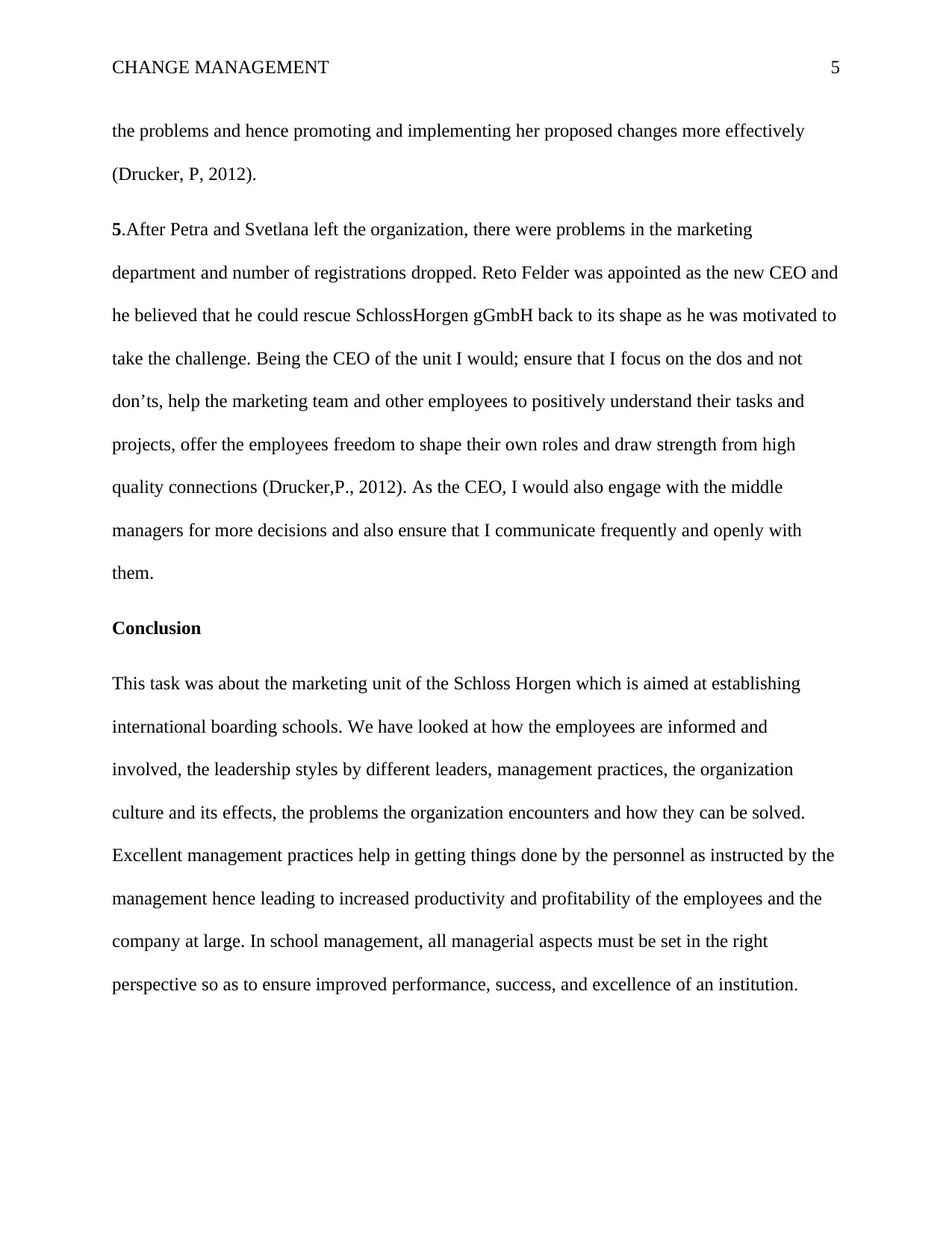
CHANGE MANAGEMENT 5
the problems and hence promoting and implementing her proposed changes more effectively
(Drucker, P, 2012).
5.After Petra and Svetlana left the organization, there were problems in the marketing
department and number of registrations dropped. Reto Felder was appointed as the new CEO and
he believed that he could rescue SchlossHorgen gGmbH back to its shape as he was motivated to
take the challenge. Being the CEO of the unit I would; ensure that I focus on the dos and not
don’ts, help the marketing team and other employees to positively understand their tasks and
projects, offer the employees freedom to shape their own roles and draw strength from high
quality connections (Drucker,P., 2012). As the CEO, I would also engage with the middle
managers for more decisions and also ensure that I communicate frequently and openly with
them.
Conclusion
This task was about the marketing unit of the Schloss Horgen which is aimed at establishing
international boarding schools. We have looked at how the employees are informed and
involved, the leadership styles by different leaders, management practices, the organization
culture and its effects, the problems the organization encounters and how they can be solved.
Excellent management practices help in getting things done by the personnel as instructed by the
management hence leading to increased productivity and profitability of the employees and the
company at large. In school management, all managerial aspects must be set in the right
perspective so as to ensure improved performance, success, and excellence of an institution.
the problems and hence promoting and implementing her proposed changes more effectively
(Drucker, P, 2012).
5.After Petra and Svetlana left the organization, there were problems in the marketing
department and number of registrations dropped. Reto Felder was appointed as the new CEO and
he believed that he could rescue SchlossHorgen gGmbH back to its shape as he was motivated to
take the challenge. Being the CEO of the unit I would; ensure that I focus on the dos and not
don’ts, help the marketing team and other employees to positively understand their tasks and
projects, offer the employees freedom to shape their own roles and draw strength from high
quality connections (Drucker,P., 2012). As the CEO, I would also engage with the middle
managers for more decisions and also ensure that I communicate frequently and openly with
them.
Conclusion
This task was about the marketing unit of the Schloss Horgen which is aimed at establishing
international boarding schools. We have looked at how the employees are informed and
involved, the leadership styles by different leaders, management practices, the organization
culture and its effects, the problems the organization encounters and how they can be solved.
Excellent management practices help in getting things done by the personnel as instructed by the
management hence leading to increased productivity and profitability of the employees and the
company at large. In school management, all managerial aspects must be set in the right
perspective so as to ensure improved performance, success, and excellence of an institution.
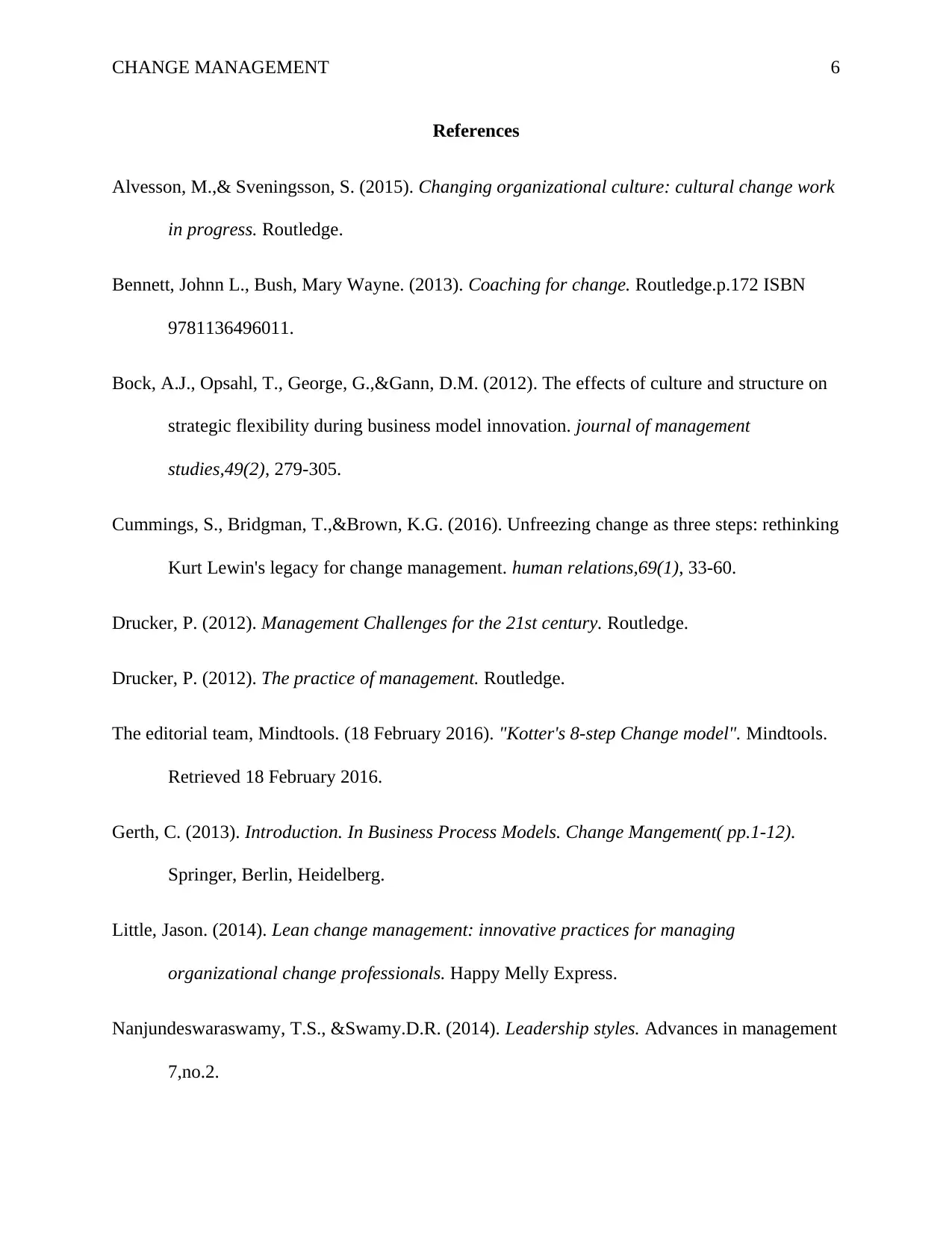
CHANGE MANAGEMENT 6
References
Alvesson, M.,& Sveningsson, S. (2015). Changing organizational culture: cultural change work
in progress. Routledge.
Bennett, Johnn L., Bush, Mary Wayne. (2013). Coaching for change. Routledge.p.172 ISBN
9781136496011.
Bock, A.J., Opsahl, T., George, G.,&Gann, D.M. (2012). The effects of culture and structure on
strategic flexibility during business model innovation. journal of management
studies,49(2), 279-305.
Cummings, S., Bridgman, T.,&Brown, K.G. (2016). Unfreezing change as three steps: rethinking
Kurt Lewin's legacy for change management. human relations,69(1), 33-60.
Drucker, P. (2012). Management Challenges for the 21st century. Routledge.
Drucker, P. (2012). The practice of management. Routledge.
The editorial team, Mindtools. (18 February 2016). "Kotter's 8-step Change model". Mindtools.
Retrieved 18 February 2016.
Gerth, C. (2013). Introduction. In Business Process Models. Change Mangement( pp.1-12).
Springer, Berlin, Heidelberg.
Little, Jason. (2014). Lean change management: innovative practices for managing
organizational change professionals. Happy Melly Express.
Nanjundeswaraswamy, T.S., &Swamy.D.R. (2014). Leadership styles. Advances in management
7,no.2.
References
Alvesson, M.,& Sveningsson, S. (2015). Changing organizational culture: cultural change work
in progress. Routledge.
Bennett, Johnn L., Bush, Mary Wayne. (2013). Coaching for change. Routledge.p.172 ISBN
9781136496011.
Bock, A.J., Opsahl, T., George, G.,&Gann, D.M. (2012). The effects of culture and structure on
strategic flexibility during business model innovation. journal of management
studies,49(2), 279-305.
Cummings, S., Bridgman, T.,&Brown, K.G. (2016). Unfreezing change as three steps: rethinking
Kurt Lewin's legacy for change management. human relations,69(1), 33-60.
Drucker, P. (2012). Management Challenges for the 21st century. Routledge.
Drucker, P. (2012). The practice of management. Routledge.
The editorial team, Mindtools. (18 February 2016). "Kotter's 8-step Change model". Mindtools.
Retrieved 18 February 2016.
Gerth, C. (2013). Introduction. In Business Process Models. Change Mangement( pp.1-12).
Springer, Berlin, Heidelberg.
Little, Jason. (2014). Lean change management: innovative practices for managing
organizational change professionals. Happy Melly Express.
Nanjundeswaraswamy, T.S., &Swamy.D.R. (2014). Leadership styles. Advances in management
7,no.2.
⊘ This is a preview!⊘
Do you want full access?
Subscribe today to unlock all pages.

Trusted by 1+ million students worldwide
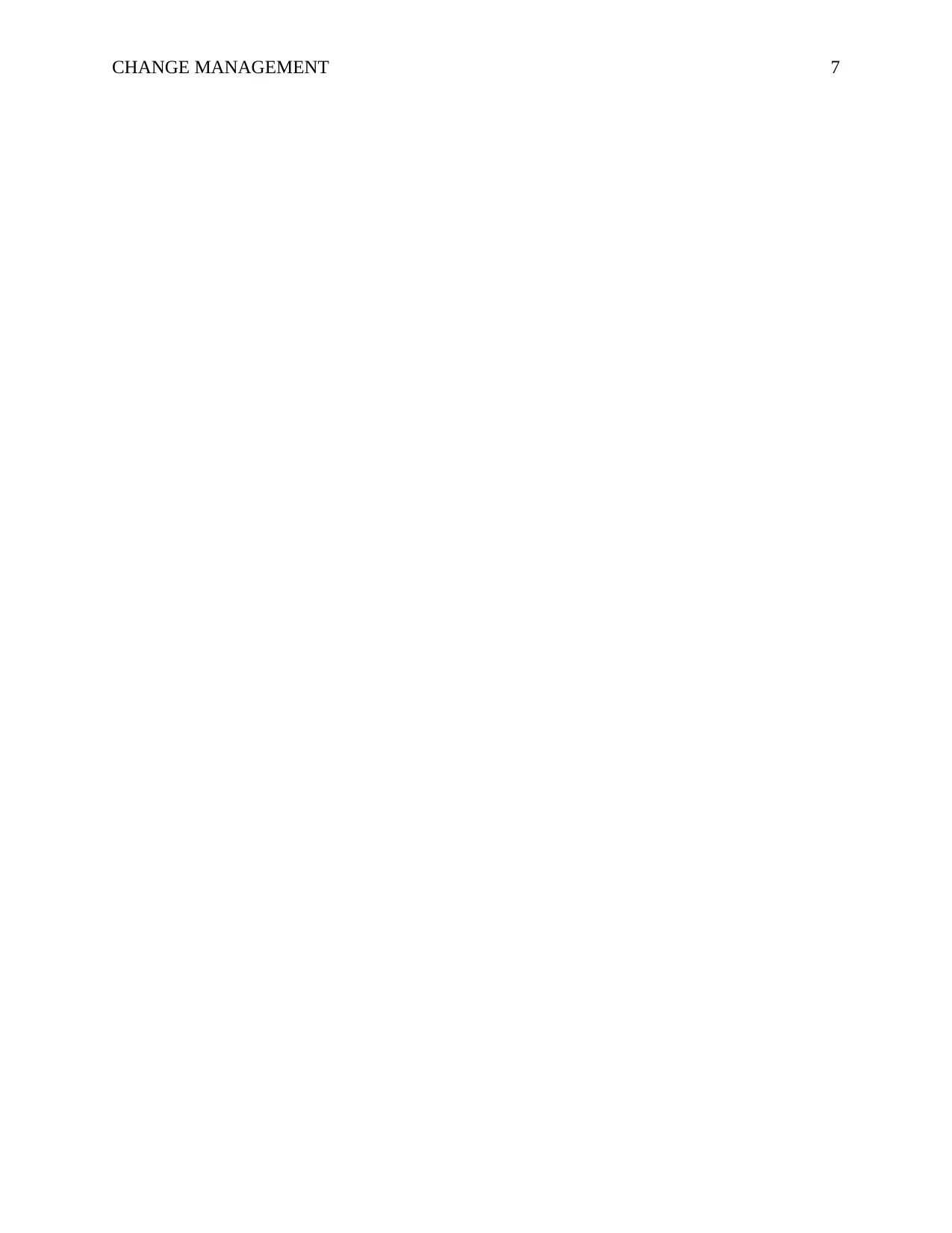
CHANGE MANAGEMENT 7
1 out of 7
Related Documents
Your All-in-One AI-Powered Toolkit for Academic Success.
+13062052269
info@desklib.com
Available 24*7 on WhatsApp / Email
![[object Object]](/_next/static/media/star-bottom.7253800d.svg)
Unlock your academic potential
Copyright © 2020–2025 A2Z Services. All Rights Reserved. Developed and managed by ZUCOL.





